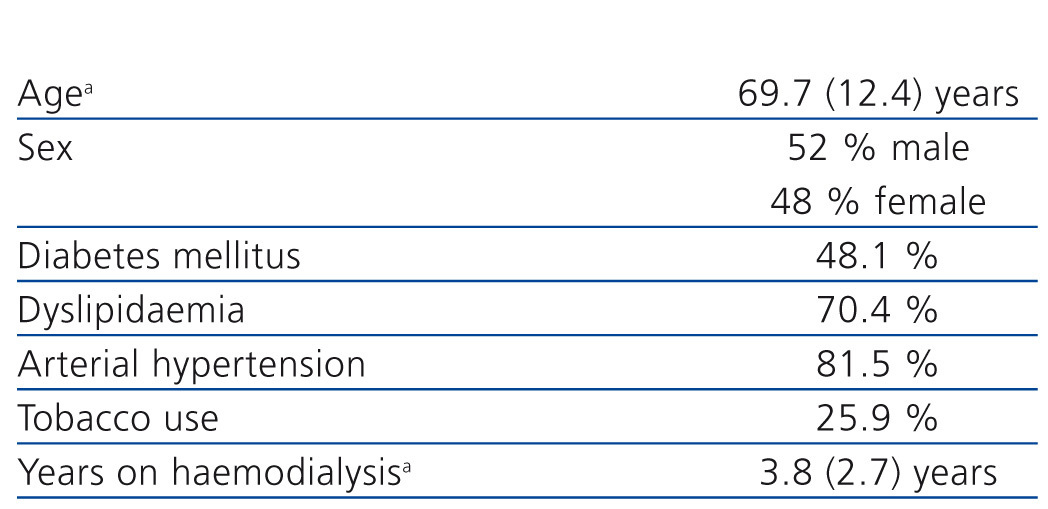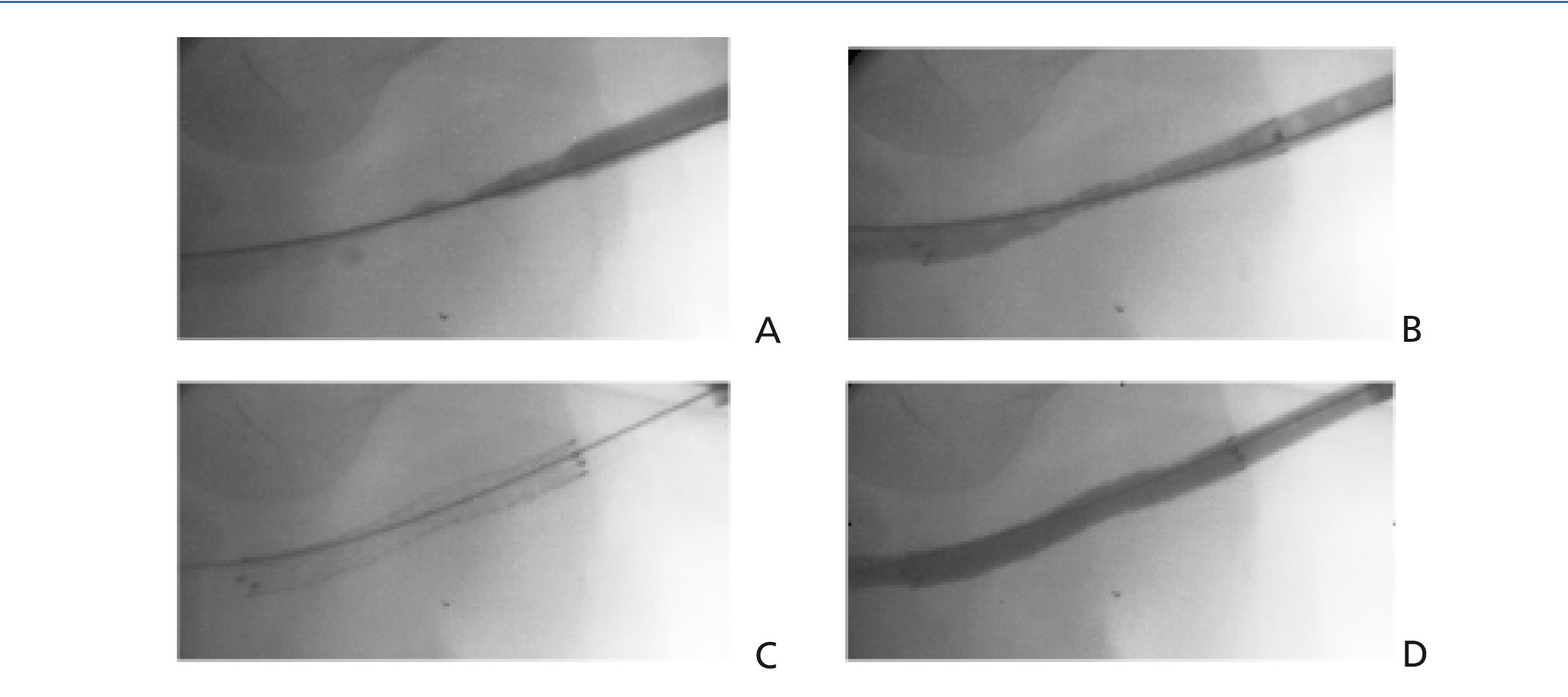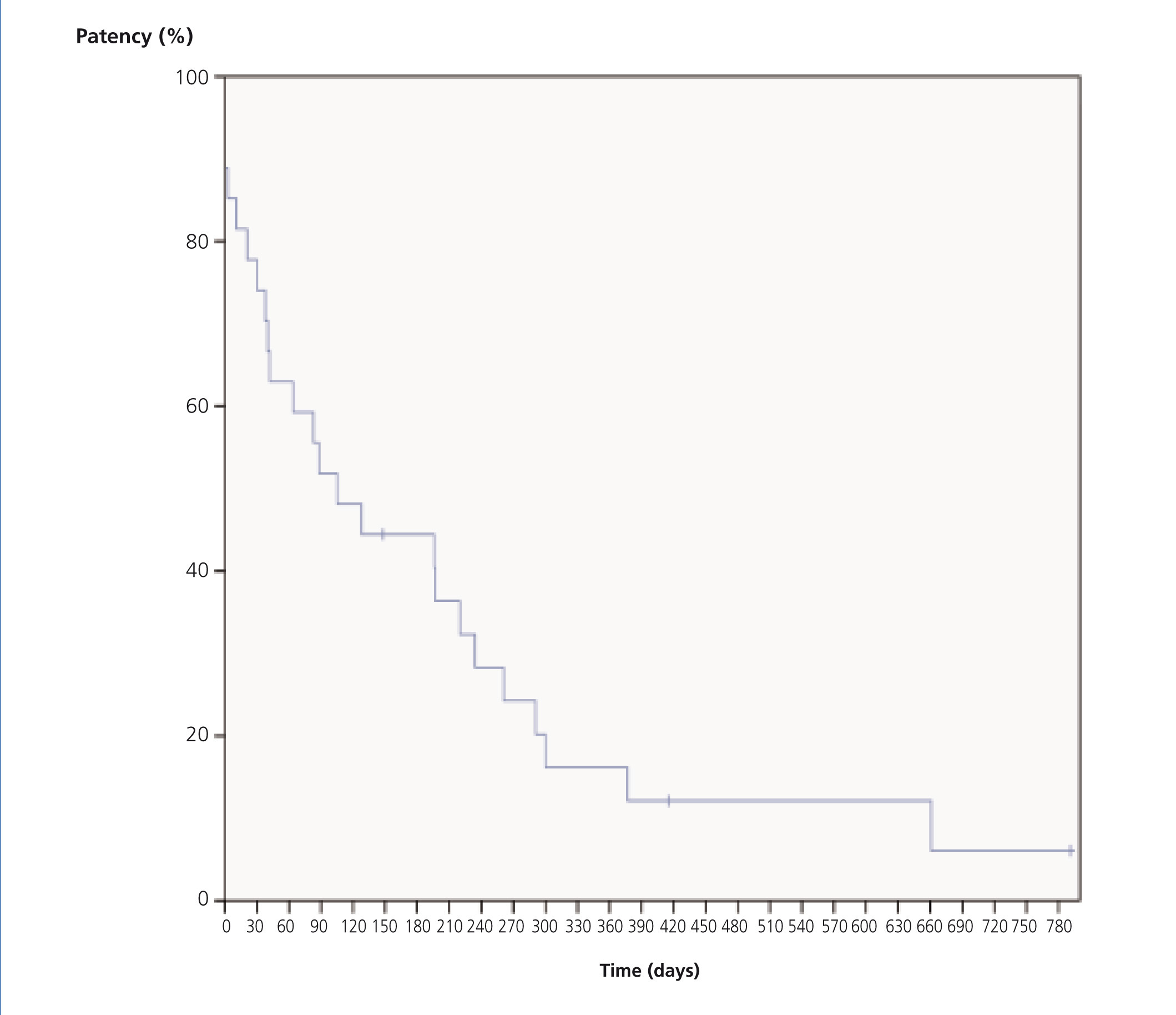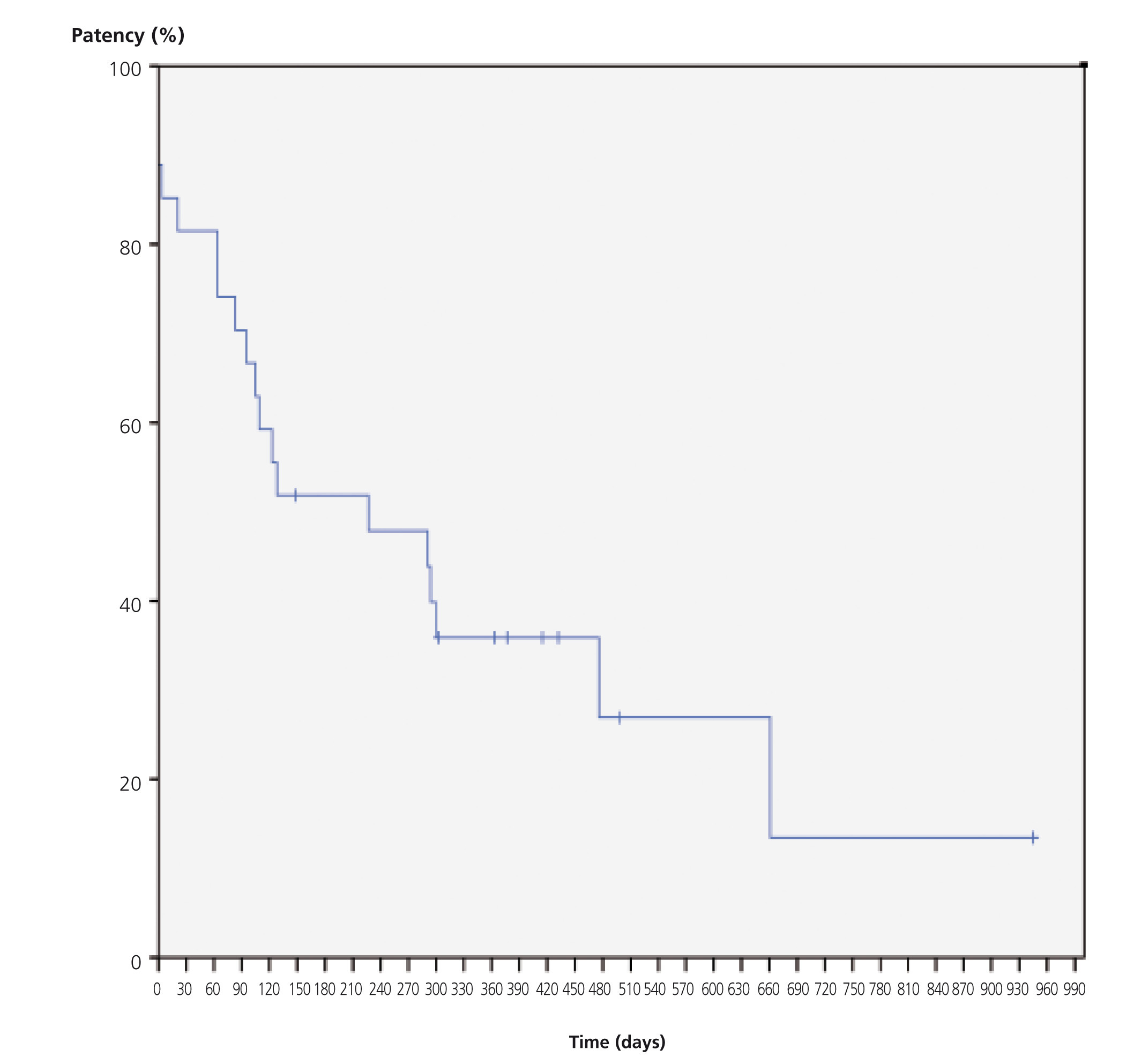Introducción/objetivo: La guía de la National Kidney Foundation-Kidney Disease Outcomes Quality Initiative (NKF-K/KDOQI) recomienda que la repermeabilización de prótesis arteriovenosas (AV) para hemodiálisis trombosadas debe alcanzar resultados favorables en el 40 % a 3 meses si es por técnica endovascular, o en el 50 % a 6 meses y el 40 % al año si es por un procedimiento quirúrgico. Este estudio evalúa los resultados de un tratamiento híbrido (endovascular y quirúrgico mínimamente invasivo) de las trombosis de prótesis AV asociadas a estenosis anastomóticas venosas. Pacientes y métodos: Entre 2008 y 2012 se intervinieron 27 pacientes consecutivos (edad media: 69,7 años; 52 % varones) con trombosis de prótesis AV (74,1 % extremidad superior) asociadas a estenosis anastomótica venosa mediante trombectomía abierta (miniincisión en trayecto), stent cubierto autoexpandible (Fluency®, Bard) y angioplastia a alta presión (> 20 atm). Resultados: La permeabilidad inmediata con hemodiálisis eficaz fue del 89 %, con una estancia media de 1,9 días y ausencia de complicaciones posoperatorias. La permeabilidad primaria a 3, 6 y 12 meses fue, respectivamente, del 51,9 %, 44,4 % y 16,2 % (seguimiento medio: 15 meses). La permeabilidad secundaria tras un nuevo episodio trombótico y procedimiento de similares características (62,9 % de los casos) fue del 70,4 %, 51,9 % y 37 %, respectivamente. Conclusiones: A pesar de ser seguro y poco invasivo, este tratamiento híbrido de las trombosis de prótesis AV asociadas a estenosis anastomóticas venosas solo alcanza resultados competitivos respecto a la cirugía abierta tras un segundo procedimiento iterativo. Debido a esto y a su coste, esta técnica debería reservarse para estenosis a las que sea difícil acceder quirúrgicamente.
Introduction/objective: The NKF-K/DOQI guidelines recommend that the repermeabilisation of thrombosed arteriovenous (AV) grafts for haemodialysis must achieve positive results in 40% at 3 months, if it is performed by endovascular technique, or 50% at 6 months and 40% at one year if it is performed by surgical procedure. This study assesses the results of a hybrid treatment (minimally invasive surgical and endovascular treatment) of AV graft thrombosis associated to venous anastomotic stenosis. Patients and Method: Between 2008 and 2012, 27 consecutive patients underwent surgery (average age: 69.7, 52% male) due to AV graft thrombosis associated to venous anastomotic stenosis (74.1% upper extremity) by open thrombectomy (mini-incision in the graft), covered self-expanding stent (Fluency®, Bard), and high pressure angioplasty (>20atm). Results: Immediate patency with effective haemodialysis was 89%, with an average stay of 1.9 days and no postoperative complications. Primary patency at 3, 6, and 12 months was 51.9%, 44.4%, and 16.2% respectively (mean follow-up: 15 months). Secondary patency after a new thrombotic episode and similar procedure (62.9% of cases) was 70.4%, 51.9%, and 37% respectively. Conclusions: Despite being safe and minimally invasive, this hybrid treatment for AV graft thrombosis associated to venous anastomotic stenosis only achieves competitive results compared to open surgery after a second iterative procedure. Because of this and the associated costs, this technique should be reserved for difficult surgical approach stenoses.
INTRODUCTION
The need for useful vascular access is essential to perform haemodialysis in patients with end stage renal disease, which must allow a continued and safe approach to the vascular system and must provide sufficient flow for an adequate replacement therapy. Autogenous arteriovenous fistulas represent the higher survival and lower complication rate vascular access and always must be considered the first choice technique1. The main indication for carrying non-autogenous vascular access, mostly polytetrafluoroethylene (PTFE) loop, is the depletion of the superficial venous system veins, either by previous nonfunctioning autogenous fistulas or insufficient calibre vessels or injured by previous punctures making them not useful for establishing an adequate autogenous access.
The main complications2,3 associated with prosthetic vascular access included infection, steal syndrome, venous hypertension, pseudoaneurysms and thrombosis. Stenosis and subsequent thrombosis represents the most common complication in this type of vascular access. Between 60% and 90% of them are located in the venous anastomosis or close to it due to intimal hyperplasia secondary to turbulence at the prosthesis-vein interface (caliber discrepancy between the vein and the prosthesis, high flow rate of blood in the anastomosis or periodic exposure to activated blood leaving the dialyzer)4-7.
The National Kidney Foundation-Kidney Disease Outcomes Quality Initiative (NKF-K/DOQI)8 guidelines recommend that whatever therapeutic option applied to thrombosed arteriovenous grafts must achieve favorable results in 40% at 3 months for endovascular, or 50% at 6 months and 40% at 1 year for surgical as well as an immediate patency of 85% for any both techniques. Until now, most of the published studies indicate superior results of traditional open surgical techniques (thrombectomy and PTFE extension in a permeable proximal vein) on endovascular procedures, with a significant advantage of the first one, in terms of relative risk; 1.32 at 30 days, 1.34 at 60 days, 1.22 at 90 days and 1.22 at 1 year, respectively9.
However, since 2002, endovascular treatment of arteriovenous graft thrombosis is offering, at least immediately, promising results10-16, this is also a treatment promoted by its less invasiveness and reduced need for hospitalisation. This study evaluates the results of a hybrid treatment (minimally invasive surgery plus endovascular treatment) of arteriovenous graft thrombosis associated to venous anastomotic stenosis.
PATIENTS AND METHOD
Between 2008 and 2012, 27 consecutive patients underwent urgent surgery (mean age 69.7 years, 52% male) due to arteriovenous graft thrombosis associated to venous anastomotic stenosis. The clinical characteristics of these patients are summarised in Table 1. The arteriovenous grafts were placed in upper extremity in 74.1% of cases. All prostheses were 6mm PTFE (GORE-TEX® Standard-Wall). The arterial anastomosis was performed latero-terminal in the distal 1/3 of the brachial artery in all cases. The venous anastomosis was performed termino-lateral in the basilic or brachial vein in 58.6%, and termino-terminal in all other cases. In addition, 27.6% of prostheses had already been treated for a thrombotic episode using traditional surgical techniques (thrombectomy and extension to a proximal vein segment).
The mean time between implantation of the arteriovenous graft and the thrombotic episode treated by the hybrid procedure was 370 days. Basically, the technique employed is summarized in the following sequence: 1) under local anesthesia, perform a cutaneal mini-incision over the graft, near the arterial anastomosis in order to allow a comfortable proximal thrombectomy and not interfere usual dialysis puncture points; 2) transverse incision over the graft and proximal and distal thrombectomy using Fogarty balloon; 3) regional heparinization; 4) diagnostic fistulogram through a 23cm 10F introducer placed across the prosthetic incision; 5) venous stenosis demonstration and catheterization thereof with a guide; 6) exchange to support centimeter guide (MagicTorque®, Boston); 7) measurements taken; 8) self-expandable covered nitinol stent release (Fluency ®, Bard); 9) high-pressure balloon angioplasty (Conquest ®, Bard) at > 20 atm; 10) fistulogram to check results and incision closure of the prosthesis with discontinuous PTFE 6/0 sutures (Figure 1). No delay was recommended in the use of arteriovenous graft for hemodialysis, once patency was reestablished.
All data were collected and analyzed using SPSS statistical software, version 15.0. Patency values were calculated using the Kaplan-Meier method, with log rank statistic to analyze the influence on it of qualitative variables studied. We considered primary patency to be the uninterrupted patency of the arteriovenous graft from the hybrid process described until the end of the follow-up with a functioning or the occurrence of a thrombotic event. In the latter case, and if the permeability of the prosthesis could be restored again using a hybrid process with similar characteristics to the previous one, was added to the new primary patency the interval until the end of trace with a permeable arteriovenous graft or the appearance of a new thrombotic event, considering that extended permeability as secondary patency. All results with a P-value <.05 were considered to be statistically significant.
RESULTS
Immediate patency (30 days) with possibility of effective hemodialysis was 89%. The average hospital stay associated with the procedure was 1.9 days and there was a total absence of postoperative complications.
Primary patency associated with the procedure at 3, 6 and 12 months was 51.9%, 44.4% and 16.2%, respectively, with standard error less than 10% (Figure 2). Primary patency was not significantly influenced by the location of the arteriovenous graft (upper or lower extremity), type of venous anastomosis (termino-lateral or termino-terminal), prior surgical repair or sex.
Throughout the follow-up (mean 15 months) 36 new similar procedures were necessary, in 62.9% of cases, by iterative thrombotic events. Secondary patency after a second procedure was raised to 70.4%, 51.9% and 37%, respectively, with standard error less than 10% (Figure 3). Stenoses responsible for new thrombotic episodes were located intra-stent in 50% (in the most proximal section) and at the end of the stent without actually affect it in 50%.
DISCUSSION
Vascular access thrombosis is accompanied by the need to place a central venous catheter to perform hemodialysis, which is associated with high rates of early or late complications. For this reason, it is advisable, whenever possible, an emergency treatment of vascular access thrombosis to preserve it and avoid the need for catheter. This treatment can be basically a surgical rescue and although endovascular procedures are also available, depending on the type of access, and the availability and team expertise8,17.
Beyond the aforementioned NKF-K/DOQI guidelines, meta-analysis of Green9, which reviews of randomized controlled trials published up to 1999 on the treatment of arteriovenous graft thrombosis, concluded that surgical thrombectomy provides primary patency results better than endovascular equivalent, with relative risks (confidence interval 95%) at 30, 60, 90 days and 1 year of 1.31 (1.07, 1.60), 1.34 (1.13, 1.58), 1.22 (1.05, 1.40) and 1.22 (1.07, 1.40), respectively, considering surgical treatment of choice in arteriovenous graft thrombosis. However, more recent studies, such as Tordoir, published in 2009 and based on a an exhaustive literature review regarding endovascular and surgical repair of thrombosed vascular access, reported better results in the application of endovascular techniques (with a mean success rate of 92% and better midterm patency results), although conclusions were difficult to extrapolate due to the wide variety of techniques used18.
Indeed, given the variety of indications in applying these procedures (access thrombosis, preventive treatment of stenosis), the different available techniques (surgical thrombectomy, mechanical thrombectomy, pharmacomechanical thrombectomy)9,19-21 and the materials used to treat the underlying vascular lesion (simple angioplasty, nitinol stent placement with or without angioplasty, covered stent placement)22-26, along with the limited number of cases that are reported and the design of studies, mostly case series, it is very difficult any comparison between different therapeutic modalities. The choice between endovascular and surgical repair therefore is increasingly in the field of controversy. However, given their lower invasiveness, endovascular techniques are assuming an increasingly important role in the treatment of these patients9-15,27-30.
Of the various reported endovascular techniques, we believe that the hybrid treatment proposed in this study has clear advantages over others. Open surgical thrombectomy through a miniincisional allows, for example, identify other causes of access thrombosis requiring open surgical treatment as those located in the proximal segment of the graft or within the prosthesis, while providing adequate access for endovascular treatment of the proximal stenosis if this turns out to be the cause of the complication. Moreover, the routine use of nitinol covered stents allows the safely treatment of these stenoses, typically elastic and highly resistant, in areas of anastomotic suture, since a simple high-pressure angioplasty may lead to a rupture in the interface between the arteriovenous graft and vein, or of the vein itself.
The recent study by Kakisis et al.23, which is probably the one that shares more technical similarities with ours, since they also present a hybrid rescue technique to treat a patient sample with similar clinical characteristics to our own, concluded that thrombectomy associated with angioplasty and implantation of self-expanding nitinol stent is associated with better outcomes that a thrombectomy plus angioplasty alone, showing a 85% primary patency values at 3 months, 63% at 6 months and 49% at 12 months in the stent group. Despite the limitations inherent to a case study with a small sample size and retrospective study design, in our study, the results of this series were more satisfactory than our own. In fact, we only observed competitive patency against Kakisis study or against traditional open surgery when taking into account the secondary patency values, that is, after a second hybrid treatment of arteriovenous graft thrombosis.
In summary, although endovascular treatment used is attractive because of its low invasiveness and reduced need for hospitalization, results of patency and costs lead us probably to reserved for those stenoses that are difficult to access surgically, allowing to extend the life of the vascular access when surgical approach is no longer possible.
Conflicts of interest
The authors declare that they have no conflicts of interest related to the contents of this article.
Table 1. Patient characteristics
Figure 1. Diagnostic fistulogram through the introducer placed within the arteriovenous graft. This image displays: a stenosis posterior to the venous anastomosis (A), placement of the stent at the site of the lesion (B), stent dilation (C), and fistulogram demonst
Figure 2. Primary patency
Figure 3. Secondary patency













